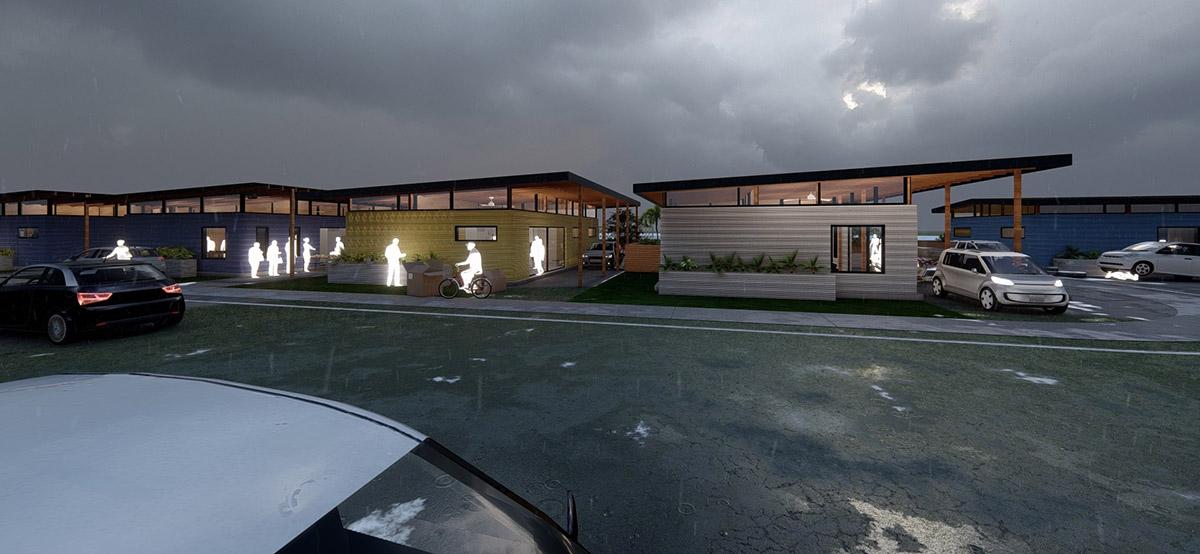The most nerve-wracking part of Christian Romero’s thesis defense was not presenting to a jury of award-winning architects or an audience of faculty, mentors and classmates; it was the fact that his grandmother was watching.
After all, it was early childhood experiences visiting his grandparents in El Salvador that inspired his project, a crowd-sourced, vibrant mix of affordable housing, community gardens and amenities for La Union, a municipality where his grandmother lives in El Salvador.

Romero grew up just minutes from campus in Lewisdale, Maryland, after his parents fled the violence of El Salvador during its enduring civil war. His thesis project stems from memories of staying at his grandmother’s house during family visits; while he loved learning to feed the chickens and spending time with his grandparents, it was other experiences—finding the outhouse in the dark, the heat and mosquitos and bathing with a bucket—that loomed large in his mind.
“I hated it,” Romero reflected during his presentation. “Of El Salvador’s six million residents, two million live in poverty with less than $3,000 in annual income. Behind the images people see in the news are human beings, like my grandparents, who deserve the same dignity and standard of living as anyone else, and that can get lost.”
But with peace and a newly-elected president, Romero saw a brighter future for El Salvador, and an opportunity to revisit his family’s country armed with his new skills as an architect. From that desire grew the idea for El Pueblo de Capas, a beautiful residential community that Romero planned to design by traveling to El Salvador during the summer of 2020 for research. Then the pandemic hit.
“I panicked a bit,” he laughed. “How was I going to get the input of my family, the community? But, they all use Instagram, Facebook and WhatsApp, so I thought, maybe I can reach them through social media. As it turned out, I got a lot of valuable information and design decisions that way.”
Through an exhaustive series of visual Instagram polls, Romero engaged over 100 residents of El Union to influence house typologies and layout, community amenities, green space and programming. A domed housing style modeled after ancient cultural typologies of the region’s past, a design decision Romero thought would be a home run with residents, fell flat in the polls, with 93% preferring an angular, modern design. Romero initially didn’t include much space for parking, until residents alerted him to a need for mechanics working from home.
“There’s a huge entrepreneurial spirit in El Union and I soon realized they needed space to pursue that,” he said.
Taking a page from garden cities like Greenbelt, Maryland, the community layout comprises a series of cul-de-sacs linked to community parkland, recreation and community amenities. In a cost-effective departure from traditional construction, Romero leveraged 3D printing to create colorful, customized housing typologies, from both one-family and generational homes to farming communities. A design check list offers residents a choice of several floorplans, exterior colors, window placement and façade type. While timber roofing is installed by locals to build ownership and support the microeconomy, a 3D printed home is incredibly cost effective and can be printed in about two days.
“The idea of using 3D printing just clicked, because it’s a building method of the future to respond to the problems of today,” he said. “There’s misconception that 3D printing is designed for the wealthy when, in fact, it’s designed for people who really need it.”
The presentation was capped with several “day in the life” representations of how different residents—from a teacher to a baker—might engage with their home and the community amenities, painting a picture of El Union’s potential. Saved for last was Abuelita Nicha, a local grandmother who checks her washing machine before going outside to teach her grandson to feed the chickens.
“Christian's project shows how productive and meaningful it can be to gather real feedback from people outside the discipline during the design process,” said Lindsey May, assistant director of the Architecture Program. “He wouldn't have had the same thesis if he hadn't sought outside input. I haven't seen a thesis student incorporate feedback and stakeholder research directly into their thesis in this way before, which made his way of working very exciting.”
The jury praised Romero for utilizing 3D printing and its design potential. His father wept at the references to Romero’s late grandfather, sprinkled throughout the presentation. The same pandemic that prevented Romero from visiting his grandmother last summer allowed her to watch virtually, with translation help from Romero’s cousin, thousands of miles away.
“My family is my inspiration,” said Romero. “No matter how much they struggled and sacrificed, it was to make us a better life. I was always taught to find a reason for your path; my reason is to help those in need based off of the struggles we’ve lived through and the stories we’ve been told.”


